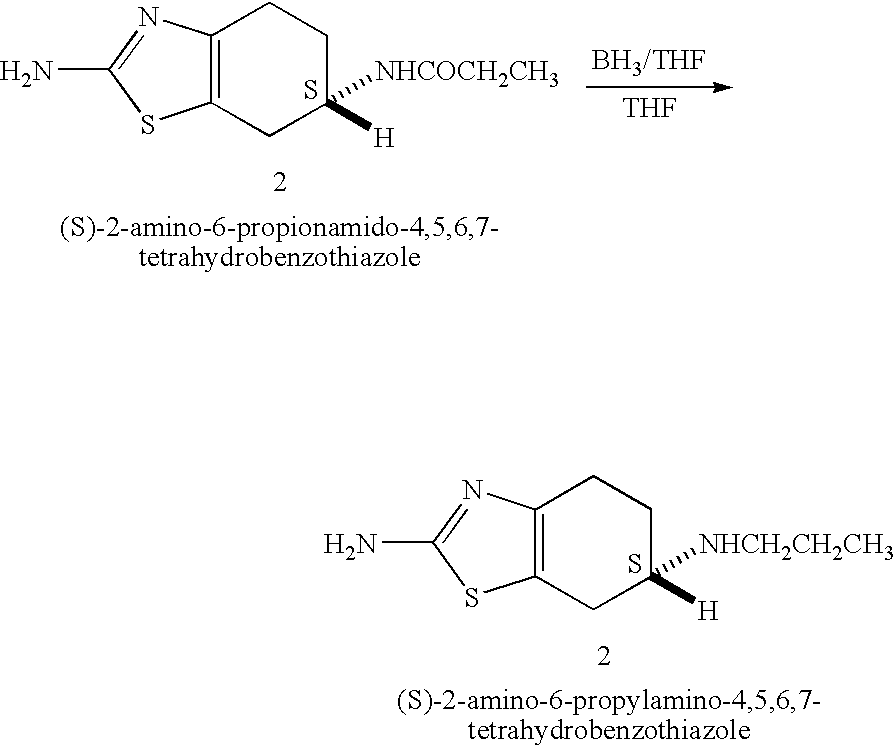Process for the reduction of (S)-2-amino-6-propionamido-4,5,6,7-tetrahydrobenzo-thiazole
a technology of amino-6propionamido and a process, applied in the field of improved process for the reduction of (s)2amino-6propionamido4, 5, 6, 7tetrahydrobenzothiazole, can solve the problems of thermal instability of the reaction, increase in the assay, and high toxicity, and achieve the effect of convenient separation
- Summary
- Abstract
- Description
- Claims
- Application Information
AI Technical Summary
Benefits of technology
Problems solved by technology
Method used
Image
Examples
example 1
[0042] A 250 ml reaction vessel equipped with a magnetic stirrer, nitrogen inlet and a reflux condenser was charged with 50 ml of dry 2-methyltetrahydrofuran and 15.5 ml of borane dimethyl sulfide complex and the solution was stirred at room temperature. 4.6 g of (S)-2-amino-6-propionamido-4,5,6,7-tetrahydrobenzothiazole were added in portions. The reaction mixture was heated to 50° C. to afford a clear solution. After 2 hours the reaction mixture was cooled to 5° C. and 6.7 ml of methanol were added in portions while maintaining the temperature at 5° C. A mixture of 11 ml of water and 15.7 ml of HCl solution (32%) were added to afford a suspension. The reaction mixture was allowed to warm to room temperature and 30.9 ml of aqueous sodium hydroxide (25%) solution were added in portions followed by addition of 42 ml of 2-methyltetrahydrofuran. The reaction mixture was heated to 50° C. to afford a two phase system. The reaction mixture was cooled and the layers were separated. The org...
example 2
[0044] A 250 ml reaction vessel equipped with a magnetic stirrer, nitrogen inlet and a reflux condenser was charged with 50 ml of dry tetrahydrofuran and 15.5 ml of borane dimethyl sulfide complex and the solution was stirred at room temperature. 4.6 g of (S)-2-amino-6-propionamido-4,5,6,7-tetrahydrobenzothiazole were added in portions. The reaction mixture was heated to 50° C. to afford a clear solution. After 2 hours the reaction mixture was cooled to 5° C. and 6.7 ml of methanol were added in portions while maintaining the temperature at 5° C. A mixture of 11 ml of water and 15.7 ml of HCl solution (32%) were added to afford a suspension. The reaction mixture was heated to reflux and the majority of the tetrahydrofuran-water mixture was distilled out at atmospheric pressure to a final volume of about 20 ml. The reaction mixture was allowed to cool to room temperature and about 31 ml of aqueous sodium hydroxide (25%) solution were added in portions followed by addition of 92 ml of...
example 3
[0045] A 250 ml reaction vessel equipped with a magnetic stirrer, nitrogen inlet and a reflux condenser was charged with 50 ml of dry tetrahydrofuran and about 14 ml of borane dimethyl sulfide complex and the solution was stirred at room temperature. 4.6 g of (S)-2-amino-6-propionamido-4,5,6,7-tetrahydrobenzothiazole were added in portions. The reaction mixture was heated to 50° C. to afford a clear solution. After 1 hour the reaction mixture was cooled to room temperature and a mixture of 10 ml of water and 20 ml of HCl solution (32%) were added to afford a suspension. The reaction mixture was heated to about 60° C. and the majority of the THF-water mixture was distilled out under vacuum. 60 ml of aqueous sodium hydroxide (25%) solution were added in portions and the reaction mixture was stirred at room temperature for 1 hour. The mixture was cooled to 5° C. and stirred for additional 1 hour. The precipitate was filtered, washed with cold water and dried at 60° C. under vacuum to y...
PUM
 Login to View More
Login to View More Abstract
Description
Claims
Application Information
 Login to View More
Login to View More - R&D
- Intellectual Property
- Life Sciences
- Materials
- Tech Scout
- Unparalleled Data Quality
- Higher Quality Content
- 60% Fewer Hallucinations
Browse by: Latest US Patents, China's latest patents, Technical Efficacy Thesaurus, Application Domain, Technology Topic, Popular Technical Reports.
© 2025 PatSnap. All rights reserved.Legal|Privacy policy|Modern Slavery Act Transparency Statement|Sitemap|About US| Contact US: help@patsnap.com


